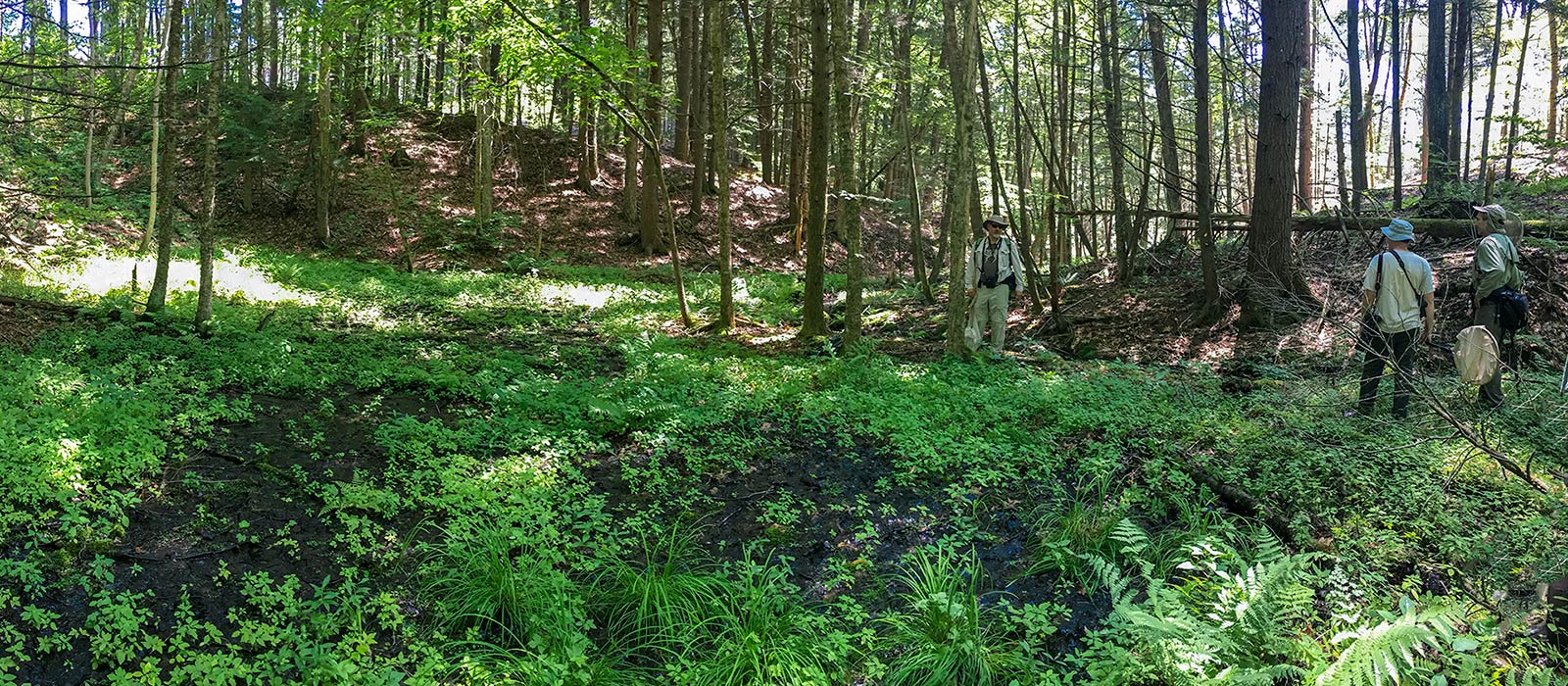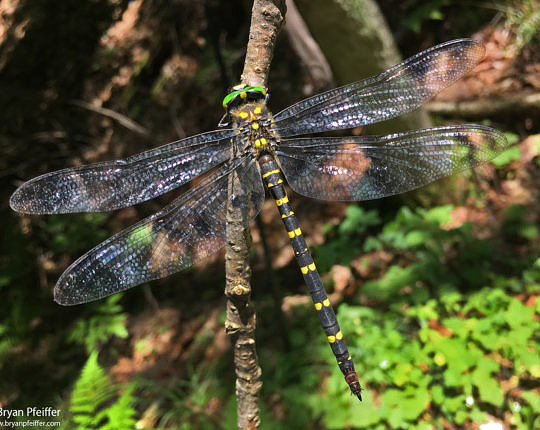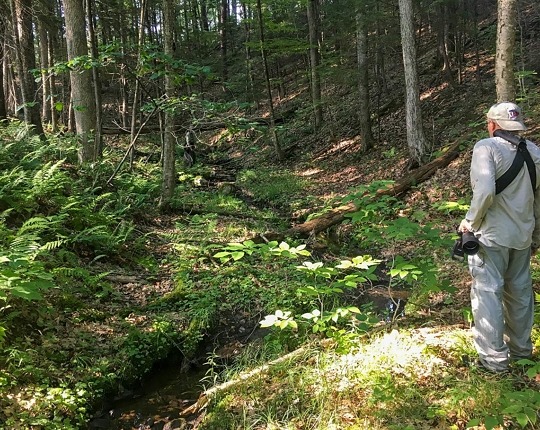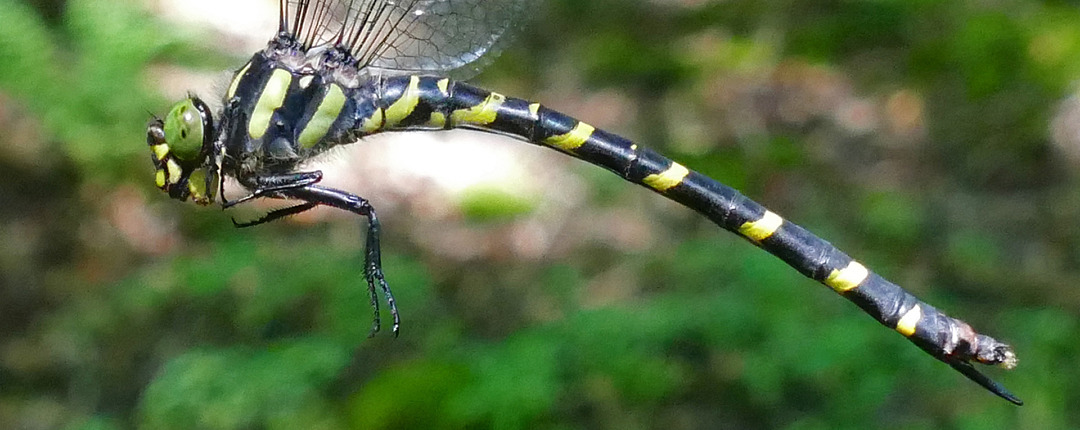
A Tiger Tale
A Dragonfly Mystery Solved in a Vermont Forest
This patch of sun-dappled woods in southern Vermont at first wasn’t particularly unusual, except maybe for the half-dozen men and women stationed at points along a rivulet, each of us clinging to reason, to hope and to an insect net — and each waiting for a phantom.
Sure enough, without warning (and I’ll admit much to my surprise), the phantom descended from the treetops and began to patrol the stream like a little fighter jet, searching for an insect to kill or, more likely, a mate. When it instead spotted one of the men, the phantom stopped and hovered at eye-level.
“Here’s one!” the man shouted, swinging his net to capture nothing but air and humidity as the phantom rocketed away toward the heavens. This happened several times. And each time we were not quite certain of this beast’s identity.
But the rivulet was a compelling force in the life of this dragonfly, like gravity or love or addiction. And when it returned yet again to zig-zag along its way, this time toward me, I swung and soon heard the pleasing rattle of rugged wings against nylon mesh.
At that moment, the phantom became fact. Beside that rivulet on Friday, our team solved a two-year mystery when I pulled from my net an imperiled insect, an elusive dragonfly of high regard called Tiger Spiketail (Cordulegaster erronea). But more than a dragonfly and a cause for celebration, this discovery is a testament to an insect’s rightful place in Vermont’s forest and conservation traditions. (Okay, well, it’s also a story about a very cool dragonfly and a chance photo that set this expedition in motion.)
[] [] []
Our journey to this particular forest rivulet began exactly two years ago today when a fisherman, Dale Ferland, out with his son on the Black River in Springfield, Vermont, snapped a photo of a charismatic dragonfly with emerald eyes, a black body and bold yellow markings. Until Dale’s photo made its way to me, the Tiger Spiketail had not been on our radar here in Vermont. It has a patchy distribution across eastern North America, mostly to our south.
It also had no business being on big rivers like the Black. Tiger Spiketail is instead a habitat specialist, limited largely to spring- and seepage-fed headwater streams running through mature forests. So, was Dale’s spiketail merely a one-off, a wayward individual that somehow flew out of its range and into Vermont?
It might have been easy to dismiss it as such. But Tiger Spiketail is a compelling beast, among the few dragonfly species that live not in the open sunlight, not at wetlands, lakes, ponds and rivers, but rather in forests. Spiketails, by the way, get their name from the habit of the female, who hovers and bounces, sort of like a pogo stick, as she lays her eggs with a spike-like ovipositor in streams. We’ve got 10 spiketail species here in North America, one of which, Sarracenia Spiketail (Cordulegaster sarracenia), specializes in pitcher plant bogs of the American Southeast and was only recently described to science (Abbott, 2011). I had the good fortune of seeing it in Louisiana this past April.
Tiger Spiketail also turns out to be a kind of conservation icon across the northeastern U.S., ranking as a top priority in a major dragonfly conservation assessment (White, 2014), one of whose co-authors, Pam Hunt, joined our search last weekend. So, with Dale’s photo as our lead, if we could find a breeding population of spiketails here in Vermont, we would then join in the shared responsibility to protect this elusive insect. Besides, who doesn’t like a good mystery anyway?
So a few weeks ago I began to scope out possible breeding sites in forests not far from where Dale went fishing. And luckily for me, and for the spiketail, another force for nature on the river, Kelly Stettner, had also been plotting and planning. Kelly directs Black River Action Team, which is doing noble work protecting the river and engaging folks in all that it has to offer us. Coincidental to a BioBlitz held in the watershed last weekend, Kelly had persuaded the Dragonfly Society of the Americas (of which I am president) to hold its Northeast regional meeting in Springfield (I swear that I had nothing to do with this).
Yet even though we had about two dozen eager dragonflyers in the area, we also had many forested streams to visit and many more still to be discovered. But it turned out that we chose well. I netted the spiketail on our very first morning of the search — at our very first site of the day.
What’s perhaps most amazing to me is how easily none of this could have happened were it not for a confluence of smart and motivated people. During my map analysis of potential sites, Bob Zaino, an ecologist with the Vermont Fish and Wildlife Department, directed me toward the new Muckross State Park just above the Black River. I added it to my site list. Then Kelly mentioned a spot she liked on private land above the park. Two property owners up there were particularly supportive, granting our team access: Phil Drinker, who sent us off in the right direction toward the stream from his farm (and hosted everyone for moth lighting one night), and the good folks at Tree Farm Campground, on whose property we made the big discovery.
On Friday, just as I myself grew a bit wary of this first site, Josh Lincoln spotted a spiketail on the wing, and later a female spiking her eggs into the stream. And when our hope might have faded a bit more, Steven Daniel walked higher and higher along the little stream, toward a lovely seep, which turned out to be a sweet spot for this dragonfly. It also turned out to be 0.93 miles (as the spiketail flies) from where Dale, who didn’t know much about dragonflies at the time but was aware of Kelly’s interest in these insects, snapped his photo two years ago. Had Dale not taken that shot, I most likely wouldn’t be writing this for you now.
But the circle around this insect grows even larger — and yet closes in a way. Hannah Phillips, one of my former students at the Field Naturalist and Ecological Planning Program at the University of Vermont, has long harbored a particular passion for these wet sites in our northern forests, which go by the natural community name “seepage forest.” Several years ago, when Hannah first brought them to my attention, I said, “You know, there might be a few cool dragonflies at these sites.”
It turns out I was right. And the searching has only just begun. I expect we’ll discover more Tiger Spiketail populations in these forested headwater wetlands. And I’ve now set my sights on another dragonfly species, a ghost of woodland seeps called Gray Petaltail (Tachopteryx thoreyi), which, if it’s here in Vermont, should be easier to find because it likes to land in plain sight on pale surfaces: tree trunks, fence rails (like that one I photographed below in Virginia on 6 Jun 2017) or even on people (we can only hope).
Or maybe one of you, finding yourself in some seepy forest next June, up to your ankles in wonderful muck, might spy a dragonfly appressed to the trunk of a black ash. If so, please snap a photo and send it my way. We’ll begin another expedition.
References and Resources
- Abbott, John C., Troy Hibbitts. 2011. Cordulegaster sarracenia, n. sp. (Odonata: Cordulegastridae) from east Texas and western Louisiana, with a key to adult Cordulegastridae of the New World. Zootaxa 2899: 60–68.
- Moscowitz, David, Michael May. 2019. Nymph Ecology, Habitat, and Emergence-Site Selection of Cordulegaster erronea Hagen (Tiger Spiketail Dragonfly) in New Jersey with Implications for Conservation. Northeastern Naturalist, 26(1):141-154
- White, Erin L., Pamela D. Hunt, Matthew D. Schlesinger, Jeffrey D. Corser, and Phillip G. deMaynadier. 2014. A conservation status assessment of Odonata for the northeastern United States. New York Natural Heritage Program, Albany, NY.
- The Distinguished Dozen: Vermont’s Most Wanted Dragonflies by Bryan Pfeiffer. 11 May 2018. Vermont Damselfly and Dragonfly Atlas. Vermont Center for Ecostudies – Vermont Atlas of Life.








I found your website while trying to figure out what species of dragonfly is currently sitting on my deck, at Mt. Snow, West Dover,VT. I believe it’s a Tiger Spiketail, and quite big and beautiful! Thank you, I enjoyed reading about them.
Oh, THOSE Tigers are the worst team in baseball — but I still love ’em.
And here I thought the article would be about your beloved Detroit Tigers. Pretty cool how a swarm of people can find rare dragonflies.
Excellent find, congrats Bryan. Good luck with your next adventure, things are a bit easier over here.
Thanks, Doc. Great to see you, as always. I like the camp stool idea! Maybe a cooler as well with “refreshments” next time. 🙂
I enjoyed this blog Bryan. Strange that this is a species of concern and 2 1/2 hours away in Berks County , PA we had 4 survey sites where we could find them every flight season. I once sat along the seep on a camp stool waiting for them to turn around upstream and come back down again which would continue for hours. On one trip up the stream I had Tiger, Tiger, Tiger, Clamp-tipped Emerald! Weird friends group!
Enjoyed the NE DSA meeting. Very well organized.
Doc
Great seeing you too Bryan. And yes, next June for Petaltails. I would love to be there for that adventure!
Bryan, I find your stories powerful, and I’m printing this one out. Where will you send this for publication, or have you? You are a role model!
Wonderful article. Thank you!
We should start a list of those “you know you’re a naturalist when ….” Maybe I’ll do that in a separate blog post.
Thanks, Deb. Sorry you missed the meeting as well. I hope to meet you some day!
Run a light as well in there. 🙂
It is most certainly a dragonfly. Any local field guide will help you learn, Katherine. I’m not sure where you live, but drop me an email and I can suggest a guide for you. Also, Dennis Paulson’s natural history book is an excellent source of general information on damselflies and dragonflies: https://press.princeton.edu/titles/13344.html Onward!
Great to see you, Sherry (albeit much too briefly). Yep, petaltails on tap next June!
You’ve made my day. Thanks so much, Stevie.
Whoa! Thanks, Meena. I had no clue.
Glad you were part of the expedition!
You got it, Bernie (as usual)!
Thanks, Diana. Yes, these rivers and streams did provide a lovely …. confluence of events. 🙂
You shoulda been there! 🙂
Great Article – Nice Work!
What a wonderful story. All of these elusive elements coming together to a successful and satisfying conclusion. The Happy Entomologist face says it all. Thanks for another great read, Bryan.
Once again Bryan grabs a tiger by its wings! Oh how nature roars in delight when we take notice of the life we share this planet with.
Finding this tiger almost coincided with the international Tiger Day 🙂
When I see a new post in my inbox from you, I am eager to savor it. I learn so much. Thank you for all.
Stevie
Bryan, thank you for telling the tale of the Spiketail.
I had the same thoughts about finding Gray Petaltail (Tachopteryx thoreyi) in this seepy habitat. I am sure that if they are there you will find them. Great work from all involved in this adventure!
Dragonflies have always been of interest to me and I am just now
learning about them from you. So my question may seem naive:
Is this a dragonfly or a damselfly? The body seems like that of a
damselfly but the wings are outstretched. Perhaps I need a book
to read to further my knowledge….might you have one to suggest
for a “beginner”?
As always your writings and photos are treasured. And I thank
you.
Thank you! Now I have a good reason to check out the seeps in our woods.
My most favorite dragonfly and was lucky to stumble upon one a few years ago in MA sans muck! Great tale, Bryan. Sorry I missed the meeting.
You know you’re a naturalist when you can say things like “up to your ankles in wonderful muck” and mean it!